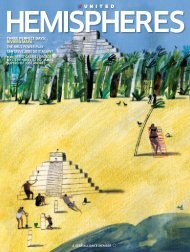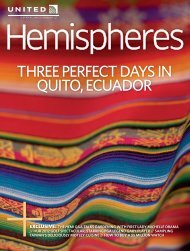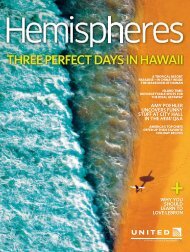june-2011
june-2011
june-2011
You also want an ePaper? Increase the reach of your titles
YUMPU automatically turns print PDFs into web optimized ePapers that Google loves.
GEORGE CERA MEETING WITH THE LOCALS ON BOCA GRANDE; AND VISITING HIS GIRLFRIEND, CINDY CRESPO, AT A LOCAL SHOP<br />
“I don’t believe in killing for sport,” he says. “I always<br />
tell my kids, if you’re gonna kill something, you’d be er<br />
be planning on eating it.”<br />
The people of Central and South America have used<br />
the iguana as a food source for centuries, referring<br />
to it as gallina de palo or “tree chicken.” (Beyond the<br />
supposedly similar fl avor, the ctenosaur’s mannerisms—<br />
head bobbing and cocking—are uncannily henlike.) The<br />
lizard was so important to the diet of Central and South<br />
Americans that the Catholic Church long ago reclassifi ed<br />
the iguana as a fi sh, permi ing its consumption on<br />
Fridays and religious holidays.<br />
“When I read that, I thought, ‘What a waste,’” says Cera.<br />
“I’d been just throwing them away. I started to compile<br />
recipes that I found and fi gured out some stuff of my own,<br />
basically substituting iguana meat for chicken.”<br />
The recipes, along with some observations about<br />
invasive iguanas became a book: Save Florida, Eat an<br />
Iguana! that Cera wrote and self-published.<br />
Not content to let me take his word on how delicious<br />
iguanas can be, Cera calls up the South Beach Bar and<br />
Grille to see if the chef would be up for lending his<br />
gastronomic fl air to the fi ve lizards we now have on ice.<br />
The chef has recently found success with beer-ba ered<br />
“gator wings” and is more than happy to research other<br />
novelty items for the bar menu.<br />
Cera hands the catch over to the eager chef, and soon<br />
lunch arrives in the form of ctenosaur tacos. Even in<br />
among the cilantro, papaya and shredded queso, my<br />
senses are relaying that I’m not eating chicken. It’s quite<br />
delicious, though I’m slightly relieved that the chef chose<br />
not to serve it on the bone.<br />
A year or so a er Cera arrived on Gasparilla, native<br />
birds like scrub jays begin to return, and the gardens are<br />
in full bloom. Locals who were less than welcoming to<br />
Cera at fi rst even went so far as to off er personal apologies<br />
for how they’d treated him when he fi rst arrived. In fact,<br />
his program may have been too successful. The USDA is<br />
planning to take over and study the remaining population,<br />
and the town is considering discontinuing his services.<br />
Cera thinks this is a mistake.<br />
“Here’s the reality: At some point you have to stop<br />
studying them and start killing them,” says Cera. “And we<br />
passed that point a long, long time ago.”<br />
The discussion in Boca Grande is whether governmental<br />
organizations or private contractors like George Cera are<br />
more eff ective at keeping invasive species’ numbers in<br />
check. Kristina Serbesoff -King and her colleague, Dr. Meg<br />
Lowman, think that the best results will be achieved when<br />
both are working in concert.<br />
“Private contractors are integral to invasive control,” says<br />
Serbesoff -King. “They have worked hand in glove with<br />
agencies throughout Florida. Yes, they are being paid to<br />
implement control eff orts, but they are also sharing their<br />
lessons learned with the larger group.”<br />
Serbesoff -King is the cochair of the Florida Invasive<br />
Species Partnership, fl oridainvasives.org. The website is<br />
a way for information on invasive species to be shared<br />
and acted upon in Florida. It’s proved a useful tool<br />
in protecting Florida’s natural species. “The way that<br />
people have been coming together to help combat this<br />
problem has helped keep me thinking positively about<br />
the task ahead of us,” she says.<br />
As we thread in and out of opulent neighborhoods on<br />
Cera’s golf cart, we catch occasional glimpses of the USDA<br />
truck, eliciting resigned head-shaking from him.<br />
“If they get about six iguanas, they consider it a good<br />
day,” he says before waxing poetic on the federal takeover<br />
of a once private enterprise. “The days of the cowboys,<br />
pirates and explorers are gone. What am I to do?”<br />
GRANT STODDARD is perfecting his iguanaburger recipe.<br />
HEMISPHERESMAGAZINE.COM • JUNE <strong>2011</strong> 95
















